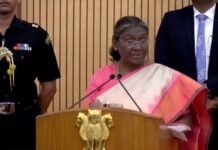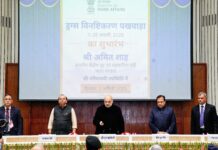By Our Correspondent
MUMBAI/BHUBANESWAR: RBI has kept the key lending rate – Repo Rate unchanged at 4 per cent for the 8th time in a row. The Reverse Repo Rate also remains unchanged at 3.35 per cent. Announcing the decisions of the six-member Monetary Policy Committee, RBI Governor Shaktikanta Das said the GDP forecast for FY 2021-22 is 9.5 per cent.
Governor Das further said “the MPC has also decided to continue with the accommodative stance as long as necessary to revive and sustain growth on a durable basis and to continue to mitigate the impact of COVID-19 on the economy, while ensuring that inflation remains within the target”.
The Governor also shared various measures taken by the RBI since the onset of pandemic to support the growth and recovery of the economy. He informed that the RBI has injected Rs. 2.37 Lakh Crore liquidity into the financial system through Open Market Operations, in the first 6 months of FY 2021-22. This is against the Rs. 3.1 lakh crore injected during the full financial year 2020-21.
Shri Shaktikanta Das announced additional measures to support small businesses and unorganized sectors. They include:Increasing IMPS (Immediate Payment Service Transaction) per transaction limit from Rs. 2 lakhs to Rs. 5 lakhs, to enhance customer convenience, enabling instant domestic fund transfer 24 x 7.
Extension of Rs. 10,000 crore On-Tap Special Liquidity Long Term Repo Operations (SLTRO) for small finance banks, till December 31, 2021.Introduction of pan-India Framework for Retail Digital Payment Solutions in offline mode, for areas with little or scarce internet access.IMPS Transaction Limit to be increased from Rs. 2 Lakh to Rs. 5 Lakh
Geo-tagging of all existing and new payment system touchpoints, to expand reach of payments acceptance infrastructure.
New fraud prevention cohort in RBI’s Regulatory sandbox, to provide further impetus to fintech ecosystem.Continuation of Enhanced Ways and Means Advance Limits and liberalized overdraft measures for states, till March 31, 2022.Continuation of classifying bank lending to NBFCs as priority sector lending, till March 31, 2022.Internal Ombudsman Scheme for NBFCs with higher customer interface, to strengthen internal grievance redress mechanism.
The Governor assured that the additional measures announced today will support small businesses and unorganized sector entities, will be helpful in remote areas with little or no internet connectivity, will expand reach of digital payments, will provide further impetus to fintech ecosystem and ensure continuous innovation in fintech.
As a relief to the States and UTs, RBI has also extended the interim enhancement of Ways and Means Advance (WMA) limits of Rs. 51,560 Crore up to March 31, 2022. “This is to help states/UTs manage cashflow amidst continued uncertainties on account of the pandemic,” he remarked.
“Consumer Price Index (CPI) inflation is moderating,” said the Governor, noting that the measures taken by the government are helping to contain volatility in vegetable prices.
CPI inflation for 2021-22 projected at 5.3%
Q2 – 5.1%
Q3 – 4.5%
Q4 – 5.8%
Q1 (of 2022-23) – 5.2%
Real GDP projected to grow at 9.5% for FY 2021-22
Q2 – 7.9%
Q3 – 6.8%
Q4 – 6.1%
Q1 (of 2022-23) – 17.2%
The Governor also gave confidence in being able to meet our export target of $ 400 Billion during FY 2021-22 as exports have remained above $ 30 US Billion in September 2021, for the seventh consecutive month.
The Governor said that the conduct of Monetary Policy in India will continue to be oriented to the domestic circumstances. “We must not rest in the glory of what has been achieved, but work tirelessly on what remains to be done”. The Governor called for combined efforts of all sectors in order to support the economy. “Overall, aggregate demand is improving but slack still remains; output is still below pre-pandemic level and the recovery remains uneven and dependent upon continued policy support”, he observed.
The full text of the Governor’s statement can be found here. Watch the address here. The monetary policy statement of the Monetary Policy Committee can be found here.



























